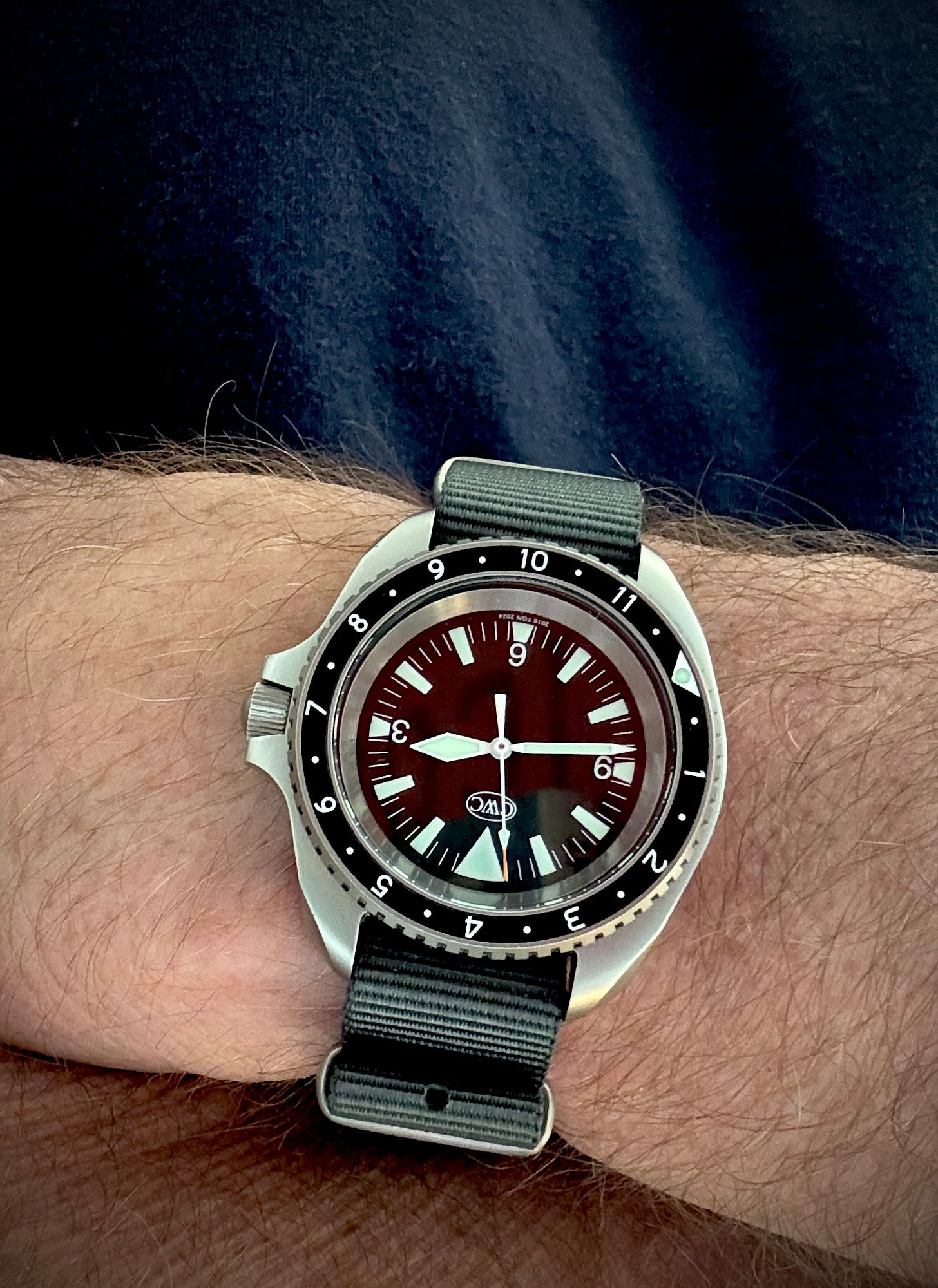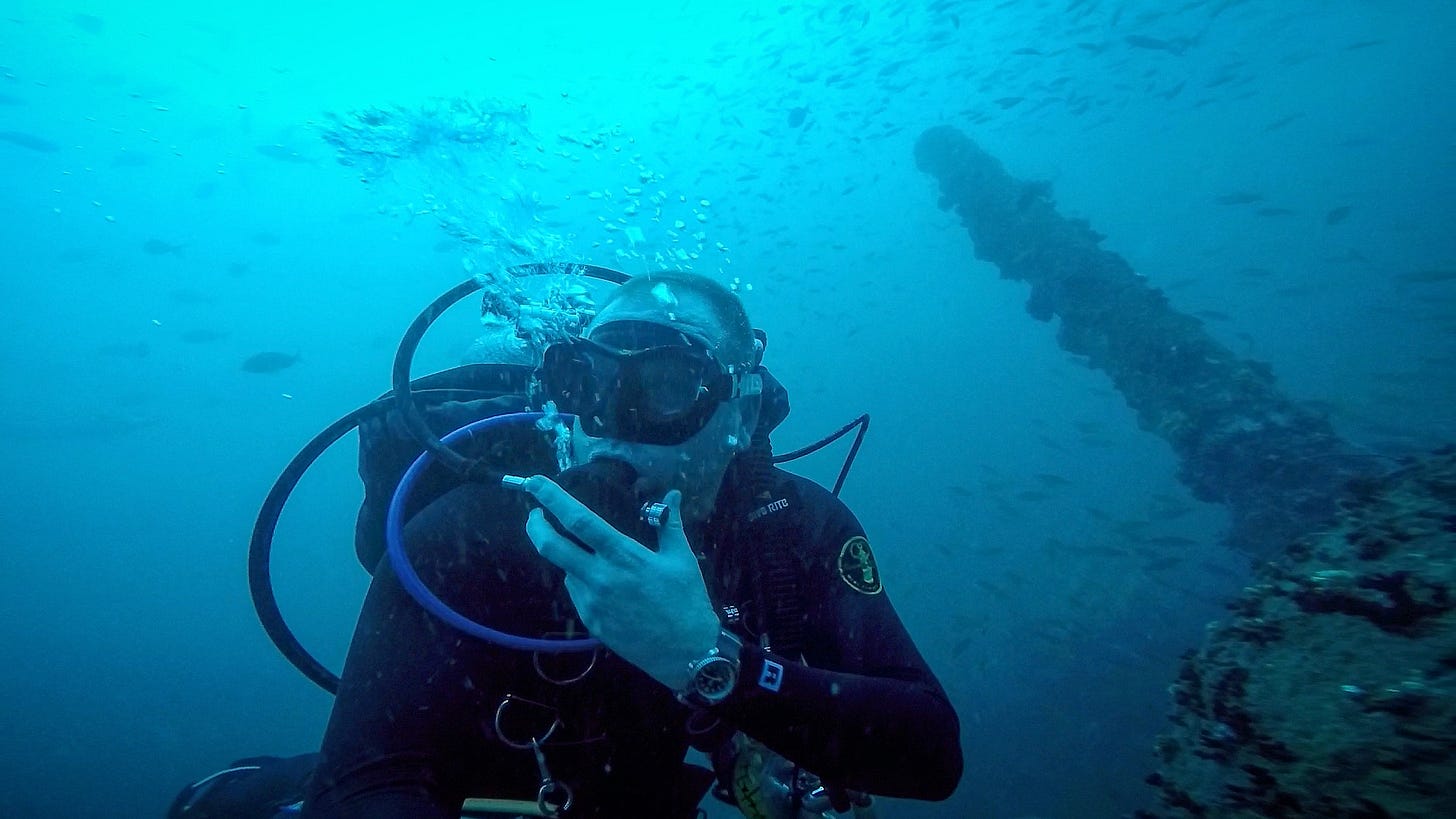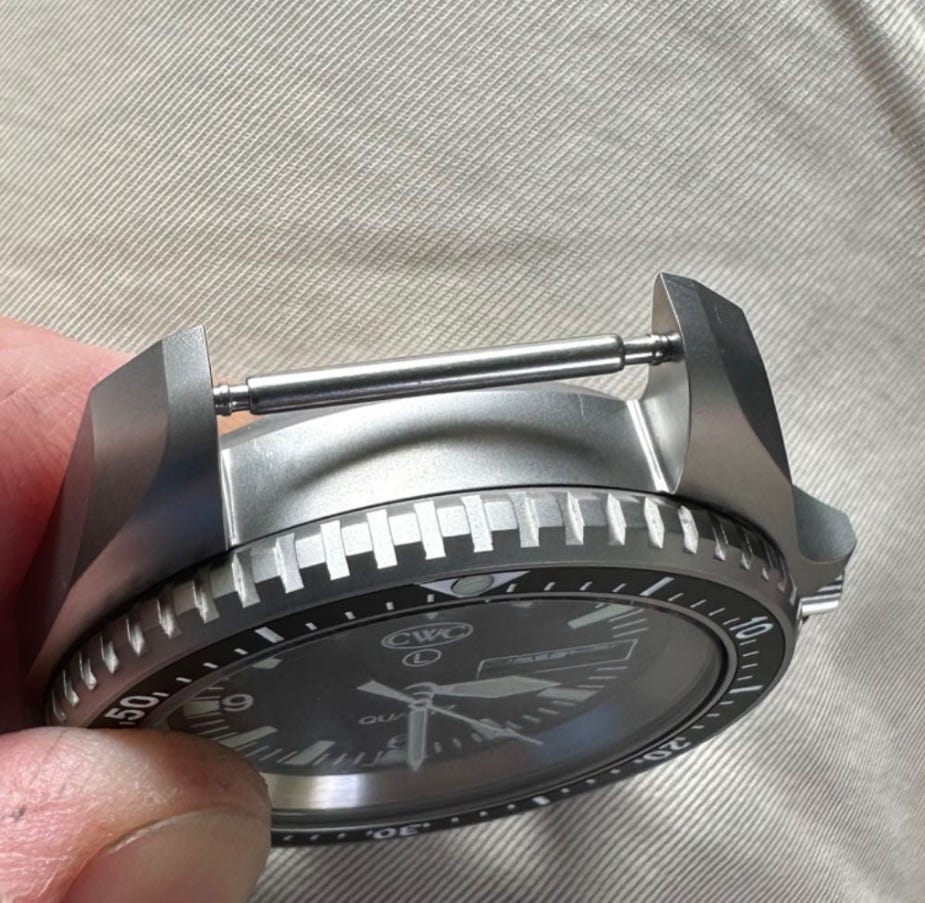Almost exactly four years ago, I wrote an article here in which I described my perfect dive watch, the one I would design. This was my spec sheet: “the fictional Heaton Diver is 42 millimeters of anodized aluminum, with a quartz movement, bi-directional bezel, a rubber strap, and 200 meters of water resistance.” In the end, I concluded no one would buy that and that I’d be better off sticking to reviewing dive watches instead of designing them. Well, fast forward to this past month, and lo and behold, there is a watch that I had a hand in designing. With my good buddy and podcast co-host, James Stacey, of The Grey NATO, we proudly saw the realization of a dream in the deliveries of a limited edition watch we designed in collaboration with one of my (our) favorite brands, Cabot Watch Company. We called it the Crew Watch No. 1, or CWN1, in honor of our subscribers, aka “the crew.” Its genesis and development was a long challenge, one in which I learned a lot, and it has made me reconsider the whole idea of creating a new watch.
I’ve come to realize that I don’t really have a head for visual design. I have a deep admiration for those who can sit down with a blank sheet of paper and create something wholly original and creative that is not simply a representation of what is in front of him or her. A wristwatch is a complicated thing with many elements, being a functional, tangible, wearable instrument. So while I am pretty good at creating a list of specifications (quartz, water resistance, strap, and so on), the visual appearance is better left to someone else. Honestly, I have little interest in reinventing the form factor of a watch. There are just so many great ones that already exist. So it’s easier, and perhaps smarter, to take something I already like and tweak it, add or subtract, maybe add a single unique flourish or improve on a functional element.
Some years ago, I was chatting with a friend who owned a commercial diving equipment supply company. The company, now defunct, made, among other things, specialized dive computers that were housed in anodized aluminum cases that they machined. Over beers, we got to dreaming about designing and making our own ultimate dive watch. He was the materials and manufacturing specialist and I was the watch “expert” so we figured we could play to our strengths. We even had a name: the Argonaut Diver. You see, we were both named Jason, and the tie-in with the Greek myth of Jason and the Golden Fleece, about a hero with our name and his merry band of sailors aboard his ship, the Argo, seemed too good to miss. But after some cocktail napkin sketches and the passage of time (aka, “life”), the idea got dropped and we went our separate ways.
With dive watches, it’s really hard to come up with anything original anymore. There are some recent examples. The Singer Reimagined DiveTrack is a spectacular example of rethinking the way a dive watch looks and functions. It is also absurdly expensive and very rare. Then there is the Blancpain Fifty Fathoms Tech Gombessa, a watch I still think is the most cleverly innovative modern dive watch, with its three-hour hand and bezel markings, for closed-circuit rebreather diving. It even looks cool, with its modernist titanium case, integrated strap, and “absolute black” dial, along with a signature Fifty Fathoms bezel. Still, very niche in its intended use, and very expensive.
I remember when I first encountered Cabot Watch Company, CWC. It was in my early days of watch enthusiasm, when I spent a fair bit of time (OK, way too much) perusing the online forums. On the Military Watch Resource, an enthusiast group within an enthusiast group (in other words, deep nerdery). CWC watches were known, namely because they were largely military issued watches, and the British military specifically. Those that found their way into civilian hands were mainly decommissioned examples and they were prized for their no-nonsense designs and rugged build. These were not luxury watches. They were something else entirely, something that appealed to my gear-oriented nature. As I wrote in a story for Hodinkee in 2017, “the appeal of CWC watches is that they were created from the get-go to be nothing more than military instruments, with no pretense or evocative name – Submariner or Seamaster – just a caseback stamped with codes and stock numbers. To those who appreciate the stripped-down utility of dive watches, or military watches in general, the CWC diver might just be the best example.”
I have owned a number of CWCs over the years, from my formerly issued 1995 Royal Navy diver, to a 1983 reissue diver, an automatic RN diver, to a version of their humble hand-wound infantry watch, and an assymetric-cased pilot’s chronograph. I’ve also developed a friendship with the current owners of the brand, the brothers Malcolm and Richard Bliss. I visited their army surplus shop in London, in which CWC is based. The whole shop, full of historical military ephemera dating back to the first World War, is evocative and inspiring and a fitting home to such an understated company that really feels more like a supplier of kit than a watch brand. I can also imagine that, in the changing ecosystem of military procurement that it would be a challenge to pivot from CWC’s traditional role to designing and selling watches to the general public, with all the marketing and branding noise that surrounds that consumer space. They seem to be doing just fine.
James and I always said privately, and sometimes publicly, that we are not watch designers, and had little desire to create a watch of our own for The Grey NATO. So often the formula for something like that involves slapping a logo on a dial, maybe a new color or strap, call it good. Fine, but not our jam. But the idea never fully left us, and when we started talking about again in early 2023, we drew up a short list of brands with whom we could imagine partnering. Of course there were considerations such as scale of such a project (we’re too small for a big brand, maybe too big for a small brand…), price (we wanted to stick close to $1,000 or less), not to mention a chemistry or general overlap of ethos. In February of 2023, I sent an email to Mal at CWC:
There were a number of back and forths after that, but immediately there was mutual interest and, in a bit of serendipity, it just so happened that CWC was already considering a titanium cased watch. As discussions continued, they agreed to work with us as the launch partner for their very first watch in that case material.
As things typically go, our correspondence was sporadic, often with months in between. CWC was having prototype titanium cases made, and James and I were noodling on design and feature specifications for the watch. We both wanted quartz for no-nonsense, grab-and-go, rugged utility. James wanted a 12-hour, 60-click bezel for travel time tracking versatility. We were in agreement on minimal dial text and very subtle “TGN” markings. I suggested a small splash of orange on the tip of the seconds hand that would be the watch’s only bit of color, a subtle nod to our TGN color code. CWC agreed to it all. They had already made a watch with a 12-hour bezel, their Sea Falcon quartz chronograph, though its diameter wouldn’t exactly fit the diver, so they would have to create a new version. Slowly, with drawings and renderings and Pantone color codes sent back and forth, a prototype took shape.
One of the first titanium prototypes CWC had made used removable spring pins, due to the difficulty of welding bars in place, like they do on their steel watches at the request of the Ministry of Defence (this combined with a pull-through strap means it’s very difficult to lose a watch to spring pin failure). CWC wasn’t happy with this, and pursued a new strategy: integrated strap channels such as on the recently introduced Tudor Pelagos FXD. Ultimately, this became the final choice for the CWN1.
In June of last year (2024) I was signed up to run the Fan Dance challenge in the Brecon Beacons mountains of South Wales. It seemed like the perfect testing ground for a prototype CWN1, not only due to the challenge itself, but also that it was tied to a British Special Forces rite of initiation and qualification, one that has likely seen hundreds of CWC watches on wrists over the decades. The day I arrived at a rental cottage base camp in Wales, a package was waiting for me from CWC: the prototype CWN1, with glued-on Sea Falcon bezel and a small tube of glue in case it fell off. I ran the event and the watch did just fine (so did I, lost toenails notwithstanding). This was the same month we opened up pre-ordering of the watch to our subscribers, and it was met with much excitement.
CWC had offered to make available up to 500 cases for us. We kept the pre-order open for a week and ended up just shy of 350 orders before closing it down. There was no turning back. Then it was all about the waiting. And with the build of a brand new Swiss watch with custom dial, caseback, and bezel, with the procurement of a specific quartz movement, plus a NATO strap with titanium hardware, there were a few sleepless nights and chewed fingernails. Not to mention this was a (mostly) well kept secret for the months between ordering and delivery. The watch was only available to our paying subscribers, making it a very exclusive edition, and since it was a brand new case for CWC, we needed to keep it under wraps. Not easy to do in this age of social media and wildfire-like sharing.
Finally—finally!—in late January, CWC sent word that the watches would begin shipping. We had commissioned a special box sleeve from a TGN listener who runs a design firm, I had edited an instruction booklet for inclusion, all the pieces were in place. Watch number 001/24 (for 2024) arrived a few days later. James received 002 on the same day. We were both thrilled with the result. Judging by the feedback from the long waiting, and perhaps long suffering, subscribers who put their faith and trust in us, and plunked down their hard earned money a full eight months earlier, others were happy with the CWN1 as well. Whew. Pour a scotch, wipe your brow, exhale.
This was all a fun and educational process, but also a stressful one at times. It was not dissimilar in some ways, to writing my novels. Despite any of the headaches along the way though, it was one of the most rewarding and immensely satisfying things I’ve done, and truly a dream come true. When someone asked Daniel Craig, after completing one of his James Bond films, if he was going to do another one, he replied, “I’d rather slit my wrists.” This was taken by many as indication that he hated the job and was done with it. In reality, he was merely exhausted and just wanted to take a break before even considering the notion. I feel the same. I’ll go back to reviewing and writing about watches for a while before thinking about designing or selling another watch. I know James feels the same. That said, just yesterday, he did write me a note. “If we ever do a CWN2…”
Note: We owe a debt of tremendous gratitude to CWC for taking the risk and working with us, and especially to our TGN subscribers who trusted us enough to pre-order a watch. Thank you! If you want to learn more about the development of the CWC CWN1, check out The Grey NATO episode 321, a chat with Mal from CWC.











"I have a deep admiration for those who can sit down with a blank sheet of paper and create something wholly original and creative that is not simply a representation of what is in front of him or her" Sorry, Jason- gonna have to disagree with you: your two published novels are just that, though in a different format. I am equally impressed the CWN1 as I am the two books.
Y'all did an amazing job with it. It's been so fun to see everyone's reaction to them in the Slack.
Haven’t taken off #49 since it arrived, everyone involved in the project is to be commended on a job well done.
Can’t wait to hear from CWC sometime in the future that they’re submitting the case design to the MOD for consideration and knowing the small part these 350 pieces have played in that